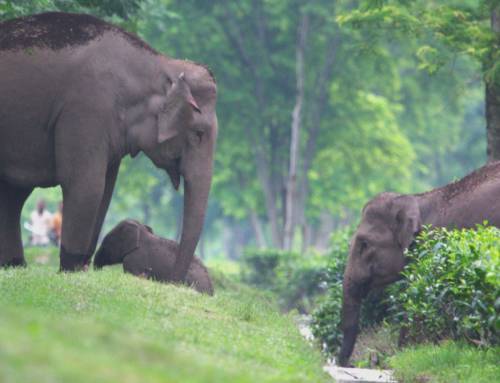Research Article: Vasudev, D., Goswami, V. R., Hait, P., Sharma, P., Joshi, B., Karpate, Y., & Prasad, P. K. (2020). Conservation opportunities and challenges emerge from assessing nuanced stakeholder attitudes towards the Asian elephant in tea estates of Assam, Northeast India. Global Ecology and Conservation, 22, e00936.
Blog Author: Simran Prasad
Key highlights:
- Human-wildlife interactions occur frequently, and understanding these encounters can shape conservation planning measures.
- An important aspect of conservation planning is to gather deeper insights on stakeholder attitudes, and the nuances that can emerge from the interactions between people and wildlife.
- The authors conducted this study in the Kaziranga–Karbi Anglong landscape (3,270km2) of Assam and sought to understand the nuances in underlying perspectives of stakeholders towards elephants.
- The study was conducted with 2,252 respondents across 17 tea estates in Assam, Northeast India.
- 80-98% of respondents expressed positive attitudes towards elephants.
- 48.24% of respondents had faced crop loss and/or property damage, while 7% of respondents were from families that had experienced injury or loss of life due to elephant conflict.
- Results indicate conservation potential in the landscape, with an opportunity to cultivate the existing tolerance and foster stakeholder support towards engaging with wildlife conservation in the future.
Conservation strategy and implementation depends on numerous factors, i.e., aims, opportunities, and challenges. Within a large, diverse landscape, human-wildlife interactions often play a crucial role in determining strategy. Consequently, the encounters people share with wildlife can shape the conservation potential that lies within the landscape. The ability to sustain and maximize conservation benefits in the long term is through fostering the support and engagement of multiple stakeholders. Stakeholders can perceive wildlife in various ways, with significant differences in the underlying values and motivations. The Asian elephant (Elephas maximus) is an animal that often evokes multiple different attitudes and perspectives in stakeholders. A conflict-prone species in India, the elephant is a wide-ranging species and can pose threats to people’s lives and their livelihoods. However, there is also a strong cultural and religious association with elephants, with many people regarding the animals as a deity.
To investigate the myriad of stakeholder attitudes, and unpack the nuances and underlying beliefs of stakeholders, the authors conducted the study in the Kaziranga–Karbi Anglong Elephant Reserve, in Assam, Northeast India. The Reserve spans 3,270 km2 and is a uniquely diverse landscape, comprising floodplains, grasslands, forests, and human-inhabited land areas. A questionnaire survey was conducted with 2,252 respondents across 17 estates to gather information on people’s attitudes towards elephants. The authors then assessed people’s attitudes based on their selection of various statements within the questionnaire survey. The results indicated that 80-98% of the respondents felt overwhelmingly positive towards elephants, and believed the animal has a right to live, mainly due to their historical presence in the landscape and the joy stakeholders experienced while watching elephants. The study also identified certain challenges and constraints with living near elephants, with 48.24% of respondents having faced crop loss and/or property damage due to elephant conflict. Seven percent of respondents were from families that had faced injury or loss of life due to the conflict in the landscape, indicating a need to implement solutions that can target these challenges.
Human–elephant conflict requires efficient, nuanced conservation solutions, and the findings of this paper indicate that stakeholder support is present, and there is a founded belief that elephants have intrinsic value in the landscape. Stakeholder engagement in conservation programs is increasingly important and has taken precedence as a fundamental requirement to understand the complexity of people’s attitudes towards conservation. In the long term, implementing more practical, landscape-specific work that focuses on human behavior in response to wildlife interactions would be able to provide more context to the intricacies of these encounters and add value to the efficacy of conservation programs worldwide that work to save threatened species.
You can access the original article here.
Keywords: Elephas maximus, Human-wildlife interactions, Landscape-scale conservation, Perspectives, Production landscapes, Stakeholder engagement




